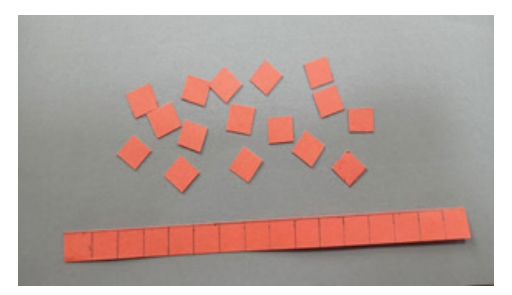Activity W2.6: Exploring Area – Same Area, Different Shapes Using Strips
Take 16 cutouts of a strip.
The dimension of the rectangle is 16 x 1 units.
Arrange them in a square shape of dimension 4 x 4 units.
These can also be arranged is a shape of dimension 8 x 2 units.
The regions in all these cases are different but the amount of region occupied by them
i.e., their areas are the same.
Ask the students to make more such cutouts, say, 20, 25, 30, etc., and make different shapes.
Activity W2.6: Exploring Area – Same Area, Different Shapes Using Strips
Objective:
To understand that area remains the same when the total number of unit tiles is the same, even if their shapes and arrangements differ.
Materials Needed:
-
Cutouts of rectangular strips of size 1 unit × 1 unit
-
Grid or chart paper
-
Scissors and glue (optional)
-
Pencil or marker
Procedure:
-
Take 16 unit strips (1 × 1) and arrange them in a 1 × 16 rectangle.
-
Rearrange the same 16 unit strips into a 4 × 4 square.
-
Rearrange them again into an 8 × 2 rectangle.
-
Observe the shape, layout, and area of each figure.
-
Try the same process with 20, 25, 30 unit strips.
Form different rectangles or irregular shapes while using all the strips. -
Record your observations.
Examples & Shapes:
| Total Unit Strips | Possible Arrangements | Area (sq. units) |
|---|---|---|
| 16 | 1×16, 2×8, 4×4 | 16 |
| 20 | 1×20, 2×10, 4×5 | 20 |
| 25 | 1×25, 5×5 | 25 |
| 30 | 1×30, 2×15, 3×10, 5×6 | 30 |
Discussion Questions:
-
Are all these shapes the same?
No. They have different shapes and dimensions. -
Do they cover the same area?
Yes. All use the same number of unit strips (same total area). -
What do we learn from this?
Area is about how much space is covered, not what shape it is. -
Can we create shapes other than rectangles with the same area?
Yes! Irregular or L-shaped figures can also be formed using the same unit strips.
Conclusion:
Even though shapes and dimensions differ, the total area remains the same when the same number of unit strips are used. This reinforces the concept that area is independent of shape and is instead determined by the total number of unit squares/tiles used.
This hands-on approach strengthens spatial reasoning and understanding of measurement and geometry.






No comments:
Post a Comment